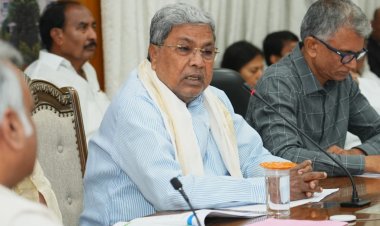In 2024, India is projected to grow at 6.2% supported by robust domestic demand and strong growth in the manufacturing and services sectors, the United Nations said.
The UN World Economic Situation and Prospects (WESP) 2024 report further said the gross domestic product (GDP) in South Asia is projected to increase by 5.2% in 2024, driven by a robust expansion in India, which remains the fastest-growing large economy in the world.
The growth projection for India at 6.2% in 2024 is slightly lower than the 6.3% estimate for 2023.
Chief of the Global Economic Division Monitoring Branch, Economic Analysis and Policy Division (UN DESA), Hamid Rashid said the Indian economy again outperformed its peers, not just this year but the last few years.
India’s economic growth has consistently remained over six per cent and we believe this will continue in 2024 and 2025 as well, he noted.
He further added that although inflation was relatively high for India, it didn’t have to raise rates as much and inflation has come down quite a bit.
The report said the growth in India is projected to reach 6.2% in 2024, slightly lower than the 6.3% estimate for 2023, amid robust domestic demand and strong growth in the manufacturing and services sectors. India’s GDP is projected to increase to 6.6% in 2025.
The report notes that economic growth in India is projected to remain strong at 6.2% this year mainly supported by resilient private consumption and strong public investment.
It highlighted that while the manufacturing and services sectors will continue to support the economy, erratic rainfall patterns will likely dampen agricultural output.
Director of the Economic Analysis and Policy Division Shantanu Mukherjee cited India’s GDP growth rates of four years from 2022-2025 and said: “I’m not sure that 7.7%, 6.3%, 6.2% and 6.6% is exactly holding something back.”
The report noted that the consumer price inflation in India is expected to decelerate from 5.7% in 2023 to 4.5% in 2024, staying within the two to six per cent medium-term inflation target range set by the Central Bank.
The risk of a surge in inflation in the coming months cannot be ruled out, however, as potential increases in commodity prices and the adverse impact of climate events on food prices could disrupt the pace of disinflation.
The UN said global economic growth is projected to slow from an estimated 2.7% in 2023 to 2.4% in 2024, trending below the pre-pandemic growth rate of 3%.
This latest forecast comes on the heels of global economic performance exceeding expectations in 2023. However, last year’s stronger-than-expected GDP growth masked short-term risks and structural vulnerabilities.
On the other hand, the global economic growth is projected to slow from an estimated 2.7 per cent in 2023 to 2.4 per cent in 2024, trending below the pre-pandemic growth rate of 3 per cent.
The latest forecast comes on the heels of global economic performance exceeding expectations in 2023.
However, last year’s stronger-than-expected GDP growth masked short-term risks and structural vulnerabilities.
The UN’s flagship economic report presents a sombre economic outlook for the near term. Persistently high interest rates, further escalation of conflicts, sluggish international trade, and increasing climate disasters, pose significant challenges to global growth.
The prospects of a prolonged period of tighter credit conditions and higher borrowing costs present strong headwinds for a world economy saddled with debt, while in need of more investments to resuscitate growth, fight climate change and accelerate progress towards the Sustainable Development Goals (SDGs).
“2024 must be the year when we break out of this quagmire. By unlocking big, bold investments we can drive sustainable development and climate action, and put the global economy on a stronger growth path for all,” UN Secretary-General Antonio Guterres said.
“We must build on the progress made in the past year towards an SDG Stimulus of at least $500 billion per year in affordable long-term financing for investments in sustainable development and climate action.”
Growth in several large, developed economies, especially the US, is projected to decelerate in 2024 given high interest rates, slowing consumer spending and weaker labour markets.
The short-term growth prospects for many developing countries — particularly in East Asia, Western Asia, Latin America and the Caribbean — are also deteriorating because of tighter financial conditions, shrinking fiscal space and sluggish external demand.
Low-income and vulnerable economies are facing increasing balance-of-payments pressures and debt sustainability risks. Economic prospects for small island developing states, in particular, will be constrained by heavy debt burdens, high interest rates and increasing climate-related vulnerabilities, which threaten to undermine, and in some cases, even reverse gains made on the SDGs.
Global inflation is projected to decline further, from an estimated 5.7 per cent in 2023 to 3.9 per cent in 2024. Price pressures are, however, still elevated in many countries and any further escalation of geopolitical conflicts risks renewed increases in inflation.
In about a quarter of all developing countries, annual inflation is projected to exceed 10 per cent in 2024, the report highlights. Since January 2021, consumer prices in developing economies have increased by a cumulative 21.1 per cent, significantly eroding the economic gains made following the Covid-19 recovery.
Amid supply-side disruptions, conflicts and extreme weather events, local food price inflation remained high in many developing economies, disproportionately affecting the poorest households.
“Persistently high inflation has further setback progress in poverty eradication, with especially severe impacts in the least developed countries,” said Li Junhua, United Nations Under-Secretary-General for Economic and Social Affairs.
“It is absolutely imperative that we strengthen global cooperation and the multilateral trading system, reform development finance, address debt challenges and scale up climate financing to help vulnerable countries accelerate towards a path of sustainable and inclusive growth,” he added.
According to the report, the global labour markets have seen an uneven recovery from the pandemic crisis. In developed economies, labour markets have remained resilient despite a slowdown in growth.
However, in many developing countries, particularly in Western Asia and Africa, key employment indicators, including unemployment rates, are yet to return to pre-pandemic levels.
The global gender employment gap remains high, and gender pay gaps not only persist but have even widened in some occupations.
Governments will need to avoid self-defeating fiscal consolidations and expand fiscal support to stimulate growth at a time when global monetary conditions will remain tight.
Central banks around the world continue to face difficult trade-offs in striking a balance between inflation, growth and financial stability objectives. Developing country central banks, in particular, will need to deploy a broad range of macroeconomic and macroprudential policy tools to minimize the adverse spillover effects of monetary tightening in developed economies, the report said.




 Join the RuralVoice whatsapp group
Join the RuralVoice whatsapp group








































